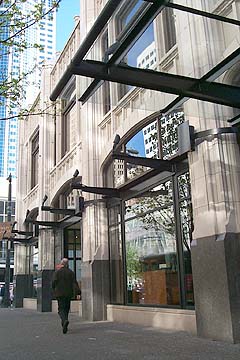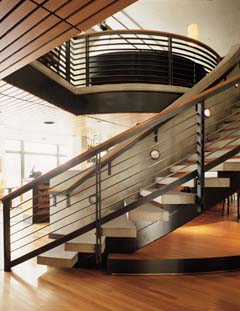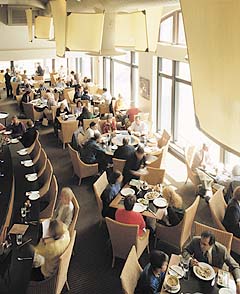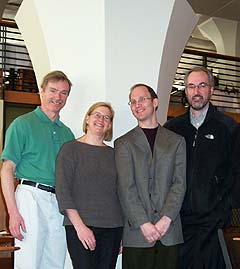|
Subscribe / Renew |
|
|
Contact Us |
|
| ► Subscribe to our Free Weekly Newsletter | |
| home | Welcome, sign in or click here to subscribe. | login |
Architecture & Engineering
| |
May 1, 2002
A terra cotta shell for intimate dining
Special to the Journal

Photo by Sam Bennett Wild Ginger now fills the first floor of the historic Mann Building. Restrained design puts food and people first. |
Wild Ginger, the pan-Asian restaurant that grew up on Western Avenue in the 1990s, is now thriving in the new downtown Seattle arts district, right across from Benaroya Hall.
It’s at home in a smartly renovated terra cotta treasure, the 1926 Mann Building, designed by celebrated Northwest engineer and architect Henry Bittman. Gone are the Turf Club and Go Guy drugs. The old Embassy Theater in the basement, lately a triple-X movie house, is an empty shell.
For Wild Ginger, the two-story storefront has been stripped down, opened up and fitted out for being seen and taking in the changing street scene. With the help of a design team from NBBJ, owner-managers Rick and Ann Yoder unpacked their popular restaurant last summer in a multi-level dining space, with two bar areas and special rooms for groups. Most of the second floor has been renovated into rental offices.
| Wild Ginger Restaurant 1411 Third Ave. |
|
Owner:
Rick and Ann Yoder Architect: NBBJ Project team includes Randy Benedict, lead designer; Chris Larson, lead interior designer; Dave Burger, technical architect; Daniel Skaggs, project manager; Yumiko Fujimori, interior designer. Music club project team: Allen Young, project manager and Daniel Cockrell, lead technical architect Project type: Renovation and remodel Size: 22,000 square feet (restaurant only) Completion date: July 2001 Structural engineer: Skilling, Ward, Magnusson, Barkshire Electrical engineer: Cochran Electric Mechanical engineer: McKinstry Lighting designer: J. Miller & Associates Acoustic designer: Shen Milsom & Wilke, Inc. & Paoletti Associates Kitchen designer: Cini-Little General Contractor: Sellen Construction Jury Comments: "A beautiful reuse and renovation of a downtown jewel. The elegance of the interior detailing reflects the restaurant’s image while setting a nice contrast to the historic exterior." "More than anything, we are pleased that this project has been accomplished ... to honor and restore a special bit of downtown architectural gingerbread on such a prominent site. The restoration of the historic outside shell is careful, understated and sophisticated, and the skillful development of the restaurant interior shows off a different set of design skills." "The exterior treatment is clean and minimal, restoring a fine historic terra cotta commercial building in the heart of the downtown core. The interior combines elegant detailing with grand spaces, yet it provides intimate dining settings as well as interesting kitchen and bar areas." "The restraint used in the exterior contrasts well with the bold, inventive design of the interior. The project clearly conveys the look and feel of the original Wild Ginger, while acknowledging the historical elements that make the formerly run-down Mann Building so interesting." |
Ironically, it was the theater, still empty in the basement, that first brought the Yoders to the Mann Building. A long-deferred dream of opening a music venue in Seattle was rekindled when they learned of the space, originally built as a vaudeville showplace.
After signing a long-term lease, the couple originally brought in NBBJ to create a theater, bar and restaurant in the basement. But terms for dividing the expenses for the partial renovation became a sticking point. In the meantime, the lease for their successful restaurant on Western was coming to an end. The owner of the Mann Building offered to sell, and a deal was struck. After the partnership purchased the building, the city announced the new symphony hall would be built right across the street.
Here was space to make many additions the Yoders had long needed for their burgeoning restaurant -- a larger kitchen, banquet rooms and best of all, a mezzanine. Despite their desire to create a music venue, the need for restaurant space took priority.
"We knew we had the goose that laid the golden egg," said Ann Yoder.
Design began with stripping away years of commercial accretion that obscured the gracefully framed bays of the exterior and filled the high-ceilinged interior. What remained were the exquisite terra cotta and granite outside walls and an interior dominated by classic flared "mushroom" concrete columns. The muscular structure of the two-story building was designed to hold yet another four stories, be added later if the need arose.
"It’s classic Henry Bittman architecture," said Ann Yoder, whose father, the world-renowned structural engineer John Skilling, was a partner in the project before he died in 1998. The real structural challenge for the renovation was seismic reinforcement. As an alternative to cross-bracing, engineers at Skilling Ward Magnusson Barkshire devised a shearwall system that divided the space only once.
Outside, there were only a few pieces of the original terra cotta missing. Replacement replicas were made, and the finish was retouched with a unique paint that imitates the finish of the original glazing. The additions bring definition to the graceful pilasters and decorative details of the exterior. Storefront door and window frames were replaced with black anodized aluminum, and a steel and glass entry canopy shelters the entry. Painted steel fixtures reach around from the framing to wash the cleaned terra cotta details with light.
The large, glazed arch that frames the main entry to Wild Ginger on Third Avenue is now perfectly aligned with a steel satay bar at the back of the expansive, two-story restaurant space. A U-shaped mezzanine wraps the main part of the restaurant, providing many site lines for enjoying the lunch or dinner scene. Steel and wood cap railings define the mezzanine. Another flute has been added to the exposed mushroom columns, bringing more scale into the various views.
Visitors can pass through the shear wall and under the mezzanine to enter an alternate dining space which fills the corner of the building at Third and Union, right across the street from Benaroya Hall. High-flying sculptural panels of stretched silk by Banner Works hang over a tables and wicker seating, which is clearly visible in the shop-front windows. A cozy bar is tucked against the partition behind, and a another plush bar and seating area is perched above at the mezzanine level. It’s more than double the space of the original Wild Ginger.

Photo by Eduardo Calderón A grand staircase sweeps patrons up to the mezzanine level of Wild Ginger. |
In the back is the large kitchen with its battery of giant woks and roasters, its quick-cook stove tops and its assembly lines for the arrangement of exquisite food.
"This is the big sister to Wild Ginger," said Ann Yoder. The menu, which consists of traditional recipes from China and Southeast Asia, has been a consistent draw for at the prior location since 1989. It’s the food that gets top priority in the design scheme at Wild Ginger -- the food and the people, according to NBBJ architects Randy Benedict and Chris Larson.
This is a downtown Seattle restaurant, and dressing runs the gamut from Armani to REI. "They all have to look good," said Yoder.
The spare, modern ambiance, with touches of Asian art, sets the scene. Subtle but strategic details put the spotlight on people and food. Over booths, light fixtures suspended from the tall ceilings shine through an etched square of glass that hovers over the center of the table. Set into beveled planks of dark wood, tables literally frame the dishes.
A few art works, guache paintings by Susan Skilling on handmade paper, are framed on the walls.
It’s all part of the strategy to create an environment that extends and refines the ambiance that worked so well at the old location, said Larson.

Photo by Eduardo Calderón A separate dining room in the corner of the building at Third and Union puts guests in full view from the street. Wicker and stretched silk sculptures by Bannerworks lighten the space. |
Larson, Benedict and the NBBJ design team have now finished design work on the multi-faceted, two-level theater, bar and dining area beneath Wild Ginger. Rick Yoder’s dream will be realized, finally, this year.
In contrast with the modernist restraint in the completed restaurant, the basement music venue will be rich in color and pattern, they said. The new nightclub will offer eclectic musical and culinary fare -- from classical to country, from tapas to satay. The new place will open early next year, with a name yet to be announced.
The sloping site resulted in a multi-level concrete shell in the basement. With 200 seats, the theater space itself will accommodate less than half of the numbers in the original vaudeville theater. But the audience will be very comfortably seated at tables along a Z-shaped ramp.
As part of the street level renovation, the old entry to the theater on Third Avenue was closed. The renovated theater space will be accessed through a new door on Union Street. A street level floor off Union, which had held a small grocery, forms a kind of shelf over audience seating and stage.

Photo by Clair Enlow Chris Larson, Ann Yoder, Rick Yoder and Randy Benedict near one of the mushroom columns inside Wild Ginger. |
Without prior reservations and with very little cash, customers can enter the street-level restaurant and bar and settle at one of the tables above the renovated theater within earshot of the evening’s live music, said Rick Yoder. Drop-in patrons can sample the music and decide whether they want to move on to any of the comfortable tables with good sight lines below.
Yoder is looking forward to giving new visibility to Seattle music talent. He’s also anticipating a certain synergy with the symphony hall. When the concert at Benaroya is over, "they can cross the street and take in the second set," he said.
He would like to see musicians at Benaroya cross the street, too. In the right place, with the kind of ambience that he will provide, cello playing would combine very well with jazz guitar and keyboard.
"Maybe after Yo Yo Ma plays at Benaroya, he comes over and jams with Bill Frizzell and Wayne Horvitz," he said.
Clair Enlow can be reached by e-mail at clair@clairenlow.com.
Previous columns:
- Serious, modern City Hall, with a friendly barn door, 04-03-2002
- Tiny Mercer Island chapel solves a small, tricky problem, 03-06-2002
- Temporary library makes a lasting impression, 02-06-2002
- Signature identity on a human scale, 01-09-2002
- Gates Hall uses the past to create a better future, 12-05-2001
- A study in flexibility, 11-07-2001
- Southeast Tower cures several ills at Swedish, 10-03-2001
- Growing Vine Street takes root at 81 Vine, 09-05-2001


